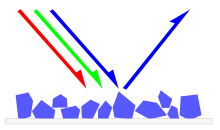Courtesy of Wikipedia.
A pigment is a material that changes the color of reflected or transmitted light as the result of wavelength-selective absorption.
Pigments appear the colors they are because they selectively reflect and absorb certain wavelengths of visible light. White light is a roughly equal mixture of the entire spectrum of visible light with a wavelength in a range from about 375 or 400 nanometers to about 760 or 780 nm. When this light encounters a pigment, parts of the spectrum are absorbed by the chemical bonds of conjugated systems and other components of the pigment. Some other wavelengths or parts of the spectrum are reflected or scattered.
 A wide variety of wavelengths (colors) encounter a pigment. This pigment absorbs red and green light, but reflects blue, creating the color blue.
A wide variety of wavelengths (colors) encounter a pigment. This pigment absorbs red and green light, but reflects blue, creating the color blue.Black is the color of coal, ebony, and of outer space. It is the darkest color, the result of the absence of or complete absorption of light. It is the opposite of white and often represents darkness in contrast with light.[1]